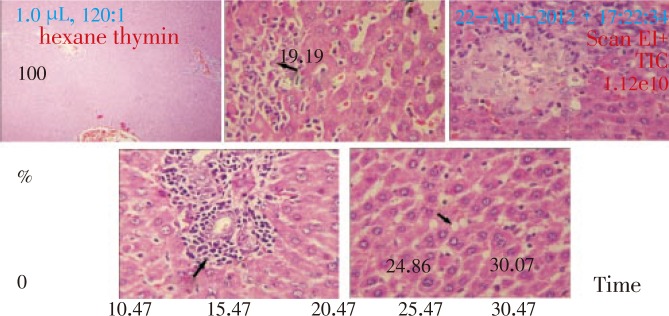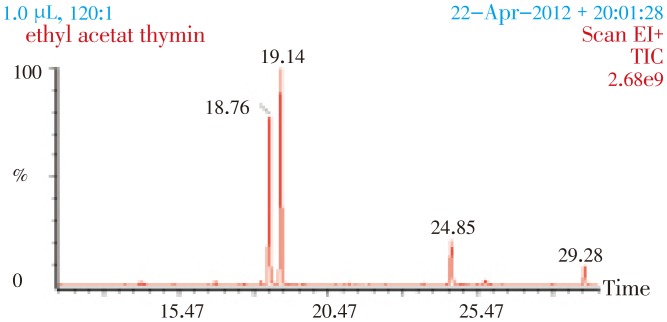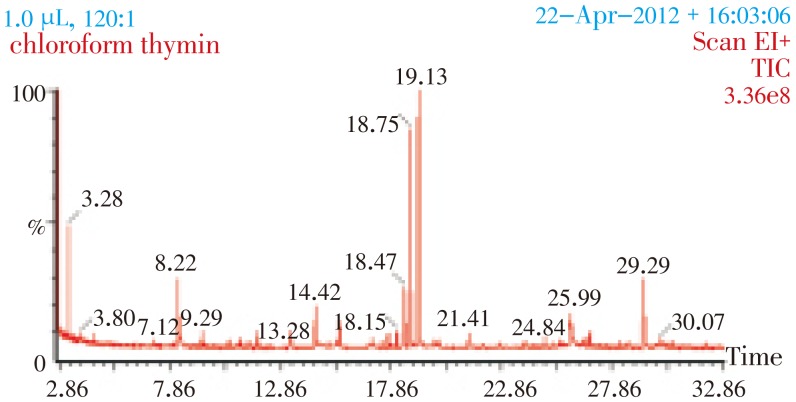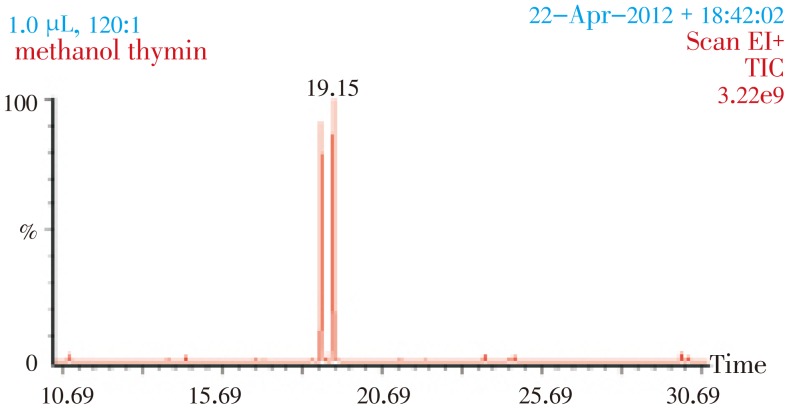Abstract
Objective
To isolate and analyze the chemical composition in different crude extracts of from the leaves of locally grown of Thymus vulgaris L (T. vulgaris) by gas chromatography-mass spectrometry (GC-MS).
Methods
The shade dried leaves powder was extracted with methanol by using Soxhlet extractor. Methanol crude extracts of T. vulgaris and the derived fractions of hexane, chloroform, ethyl acetate and butanol were obtained.
Results
Qualitative analyses of various organic crude extracts of T. vulgaris by using GC-MS showed that there were different types of high and low molecular weight compounds. Most of the isolated and identified compounds by GC-MS in the crude extracts are basically biologically important. Further, the T. vulgaris leaf possessed certain characteristics that can be ascribed to cultivation on a domestic plantation. The crude extracts were prepared from the powder leaves of T. vulgaris for respective compounds can be chosen on the basis of above GC-MS analysis.
Conclusions
All the major compounds were identified and characterized by spectroscopic method in different organic crude extracts of T. vulgaris are biologically active molecules. Thus the identification of a good number of compounds in various crude extracts of T. vulgaris might have some ecological role.
Keywords: Thymus vulgaris L, Preparation crude extracts, Soxhlet extractor, GC-MS analyses
1. Introduction
Since ancient times, all the aromatic and medicinal plants available worldwide have been used for their preservative and medicinal values, as well as to impart flavor to food and medicine formulations. Recently, there has been growing considerable interest in crude extracts and essential oils of medicinal and edible plants, herbs, vegetables and spices for the development of alternative food additives, in order to prevent the growth of food-borne pathogens or to delay the onset of food spoilage[1]–[3]. Several Thymus species are available worldwide and it is also available in Sultanate of Oman. This plant is locally known as “kekik” by the Omani population. The dried different parts of this plant species are used as herbal tea, condiments and folk medicine by the different ethnic communities in Sultanate of Oman. Thymus species have a very rich flora in Turkey and also in Sultanate of Oman. The essential oils isolated from some species of Thymus are characterized by different analytical methods shows that the presence of high concentration of the isomeric phenolic monoterpenes thymol and/or carvacrol[4]–[6].
The literature available with reports concerning the identification, characterization and determination of chemical compositions and antimicrobial properties of the essential oils of Thymus species as well as their applications in various commercial preparations mainly as antimicrobial, antifungal and antioxidant agents[7],[8]. However, according to our knowledge on the fungi, yeasts, as well as pathogenic and saprophytic bacteria of the essential oils obtained from Thymus sipyleus subsp. sipyleus var. rosulans have never been studied before by the scientist or researcher. Therefore, it is also known that the Thymus medicinal and other medicinal plants antimicrobial effects of essential oils and the crude extracts of this medicinal plants may be subjected to change based on the variations in the chemical composition of an essential oil that may be observed due to the geographical distribution, origin, the locality, the climate conditions, process, and the harvest time of the collected plant material[5],[9]. The literature search reveals that still no work have been done on this locally grown Thymus vulgaris L (T. vulgaris) by the Omani researcher. And nobody has isolated different crude extracts from different organic solvents and analyzed the crude extracts by GC-MS. This work is the first time report for the preparation of crude extracts and analysis by GC-MS. For this reason, the aim of this work was to isolate, investigate and characterize the bioactive chemical constituents in the organic crude extracts by using GC-MS from T. vulgaris native to Oman.
2. Materials and methods
2.1. Plant samples
The leaves of T. vulgaris samples were collected from Nizwa, Sultanate of Oman. The plants were harvested on 20th March, 2012 and collected in the morning session (during 10.00 a.m. to 12.00 p.m.) and packed at polyethylene bags. The samples were transported to the natural products laboratory and kept at room temperature for processing.
2.2. Preparation of samples
The leaves of plant samples were washed with tap water and dried under room temperature for 3 d. Approximately about 70 g of leaves were ground using a heavy duty grinder (Jaipan, Super Deluxe, India) for 20 seconds. The dry samples were homogenised in a grinder for 3 min to 40-mesh size. The air-dried leaves and stems of T. vulgaris were pulverized into powdered form.
2.3. Extraction procedure
The powder samples of T. vulgaris (70 g) were extracted with methanol (500 mL, 46 h) at temperature between 60–65 °C by using Soxhlet extractor. The solvent was evaporated by rotavapor (Yamato Rotary Evaporator, Model RE-801) to obtained viscous semi solid masses. The semi dry methanol crude extract was suspended in water and then extracted successively with hexane, chloroform, ethyl acetate and butanol to give hexane, ethyl acetate, chloroform, and butanol and residual methanol fractions, respectively. After fractionation of the hexane crude extract from the leaves of T. vulgaris analysed by GC-MS, it had led to the identification and characterization of 21 different organic compounds, representing 4.89% of the total extract from leaves samples. The methanol crude extract (30 g) was suspended in water and then extracted successively with hexane, chloroform, ethyl acetate and butanol to give hexane (4.89 g), ethyl acetate (3.09 g), chloroform (0.78 g), butanol (1.58 g), and residual methanol fractions (5.34 g), respectively. All the crude extracts were filtered separately through Whatman No. 41 filter paper to obtained dust free plant crude extract. The residue was reextracted twice follow the same and filtered. The combined extracts were concentrated and dried by using rotary evaporator under vacuum.
2.4. The gas chromatography-mass spectrometry analysis (GC-MS)
The GC-MS analysis of various organic crude extracts isolated from leaves of T. vulgaris was performed using a Perkin Elmer GC-MS (Model Perkin Elmer Clarus 500, USA) equipped with a VF-5 MS fused silica capillary column (30 m × 0.25 mm i.d., film thickness 0.25 µm). GC-MS spectroscopic detection, an electron ionization system with ionization energy of 70 eV was used. Pure helium gas (99.999%) was used as a carrier gas at a constant flow rate of ±1 mL/min. Mass transfer line and injector temperature were set at 220 °C and 290 °C, respectively. The oven temperature was programmed from 50 °C to 150 °C at 3 °C/min, then held isothermal for 10 min and finally raised to 300 °C at 10 °C/min. Diluted samples (1/100, v/v, in methanol) of 1 µL was injected in the split mode with a split ration 120:1. The relative percentage of the chemical constituents in crude extracts from leaves of T. vulgaris was expressed as percentage by peak area normalization.
2.5. Identification of chemical constituents
The chemical compounds in various crude extracts isolated from T. vulgaris were identified based on GC retention time on VF-5 capillary column, computer matching of mass spectra with those of standards (Mainlab, Replib and Tutorial data of GC-MS systems). Whenever it is possible by co-injection with authentic or standard compounds[10],[6].
3. Results
3.1. Physical properties
The different plant crude extracts were different in colours. The hexane plant crude extract was light brown in colour; ethyl acetate crude was pale orange in colour; chloroform crude extract was deep orange, and the butanol crude extract was blackish gray in colour.
3.2. Chemical composition of different extracts
The identified and characterization of chemical compounds in hexane crude extract are shown in Table 1 according to their elution order on a VF-5 capillary column[6]. The major chemical compounds in hexane crude extract were found (shown in Figure 1 and Table 1) as linalyl anthranilate (1.064%), α-terpineol (0.761%), thymol (40.868%), o-thymol (46.661%), thymol acetate (0.417%), bicyclo[7.2.0]undec-4-ene, 4,11,11-trime (0.902%), o-methoxy-α,α-dimethylbenzyl (1.933%), spathulenol (1.407%), α-farnesene (1.085%), 1-octadecyne (0.887%), n-hexadecanoic acid (0.642%), α-linolenic acid (0.641%) and naringenin (0.748%). m-Cymene, bicyclo[3.1.0]hexan-2-ol, 2-methyl-5-(1), o-methylthymol, thymoquinone, 1-Iodo-2-methylundecane, alloaromadendren, 3,7,11,15-tetramethyl-2-hexadecen-1-ol and squalene were obtained as minor components from the crude extract of hexane.
Table 1. Chemical composition of different extracts of T. vulgaris.
| Extracts | Retention time | Name of compounds | Molecular formula (MW) | Leave (%) |
| Hexane extract | 10.872 | Linalyl anthranilate | C8H18O | 1.064 |
| 13.979 | Bicyclo[3.1.0]hexan-2-ol, 2-methyl-5-(1- | C10H18O | 0.355 | |
| 14.519 | α-Terpineol | C10H20O2 | 0.761 | |
| 18.786 | Thymol | C10H18O | 40.868 | |
| 19.186 | o-Thymol | C10H18O | 46.661 | |
| 21.267 | 2.Thymol acetate | C10H16O | 0.417 | |
| 23.918 | Bicyclo[7.2.0]undec-4-ene, 4,11,11-trime | C10H14O | 0.902 | |
| 24.858 | o-methoxy-α,α-dimethylbenzyl | C15H24 | 1.933 | |
| 30.065 | Spathulenol | C15H24 | 1.407 | |
| 30.265 | α-farnesene | C16H32O | 1.085 | |
| 39.219 | 1-octadecyne | C16H32O2 | 0.887 | |
| 43.176 | n-hexadecanoic acid | C20H40O | 0.642 | |
| 66.436 | Naringenin | C18H30O2 | 0.748 | |
| Ethyl acetate extract | 8.221 | o-Cymol | C10H14 | 1.530 |
| 10.880 | Linalyl anthranilate | C17H23O2N | 0.502 | |
| 14.430 | 1,5-octadiene-3,7-diol, 3,7-dimethyl- | C10H18O2 | 0.444 | |
| 14.510 | α-Terpineol | C10H18O | 0.475 | |
| 18.760 | Thymol | C10H14 O | 32.438 | |
| 19.140 | o-Thymol | C10H14O | 39.820 | |
| 29.280 | 4-methoxy-2,3,6-trimethylphenol | C10H14O2 | 4.248 | |
| 30.060 | Spathulenol | C15H24O | 0.511 | |
| 39.190 | Phytol | C20H40O | 0.610 | |
| 66.460 | Naringenin | C15H12O5 | 19.417 | |
| Chloroform extract | 9.290 | 1-Iodo-2-methylundecane | C12H25I | 2.725 |
| 14.400 | 3,7-octadiene-2,6-diol, 2,6-dimethyl- | C10H18O2 | 7.606 | |
| 15.500 | 2,4-dimethylbenzaldehyde | C9H10O | 4.729 | |
| 18.800 | Thymol | C10H14O | 38.855 | |
| 19.100 | o-thymol | C10H14O | 46.079 | |
| Butanol extract | 4.225 | 4-heptanone | C6H10O2 | 10.989 |
| 4.400 | n-butyl ether | C8H18O | 33.216 | |
| 5.160 | Hexanal, 2-ethyl- | C8H16O | 3.995 | |
| 5.390 | 4-heptanone, 3-methyl- | C8H16O | 42.822 | |
| 7.241 | Butanoic acid, butyl ester | C8H16O2 | 8.975 | |
| Methanol extract | 6.976 | 5-methyl-3-heptanone | C8H16O | 0.125 |
| 8.216 | o-cymol | C10H14 | 0.326 | |
| 10.877 | Linalool | C10H18O | 1.066 | |
| 13.974 | 4-terpineol | C10H18O | 0.392 | |
| 14.514 | Terpineol | C10H18O | 0.765 | |
| 18.751 | Thymol | C10H14O | 42.262 | |
| 19.146 | o-thymol | C10H14O | 48.508 | |
| 22.027 | Thymol acetate | C12H16O2 | 0.540 | |
| 23.908 | Bicyclo[7.2.0]undec-4-ene, 4,11,11-trime | C15H24 | 1.417 | |
| 24.694 | Aromadendrene | C15H24 | 0.537 | |
| 30.051 | Spathulenol | C15H24O | 1.422 | |
| 30.261 | α-farnesene | C15H24 | 1.225 | |
| 39.195 | 3,7,11,15-tetramethyl-2-hexadecen-1-ol | C20H40O | 0.925 | |
| 43.147 | n-hexadecanoic acid | C16H32O2 | 0.483 |
Figure 1. A typical gas chromatogram of the chemical constituents of hexane extract.
The semi dry ethyl acetate crude extract prepared from the same after fractionation analyzed by using GC-MS had led to the identification and characterization of total 10 different organic compounds using the same capillary column and conditions, representing 3.09% of the total extract from leaves samples. The major chemical constituents were found in ethyl acetate extract (Figure 2 and Table 1) were o-cymol (1.530%), linalyl anthranilate (0.502%), 1,5-octadiene-3,7-diol, 3,7-dimethyl-4-methyl-2-pentyl acetate (0.444%), α-terpineol (0.475%), thymol (32.438%), o-thymol (39.820%), 4-methoxy-2,3,6-trimethylphenol (4.248%), spathulenol (0.511), phytol (0.610%), and naringenin (19.417%).
Figure 2. A typical gas chromatogram of the chemical constituents of ethyl acetate extract.
The semi dry chloroform extract prepared from same analysed by using GC-MS had led to the identification and characterization of five different organic compounds using the same capillary column and conditions, representing 0.78% of the total extract from leaves samples. The major chemical constituents analysed by GC-MS in chloroform crude extract (Figure 3 and Table 1) were 1-Iodo-2-methylundecane (2.725%), 3,7-octadiene-2,6-diol, 2,6-dimethyl-(7.606%), 2,4-dimethylbenzaldehyde (4.729%), thymol (38.8595%), and o-thymol (46.079%).
Figrue 3. A typical gas chromatogram of the chemical constituents of chloroform extract.
The butanol crude extract isolated from the leaves of T. vulgaris analyzed by using GC-MS had led to the identification and characterization of five different organic compounds, representing 1.58% of the total extract from leaves samples. The major chemical constituents that were found in butanol extract (Figure 4 and Table 1) were 4-heptanone (10.989%), n-butyl ether (33.216%), hexanal, 2-ethyl (3.995%), hepatanone, 3-methyl (42.822%), butanolic acid, and butyl ester (8.975%).
Figrue 4. A typical gas chromatogram of the chemical constituents of butanol extract.
Finally, the methanol crude extract isolated from the leaves of T. vulgaris analyzed by using GC-MS had led to the identification and characterization of 14 different organic compounds, representing 5.34% of the total extract from leaves samples. The major chemical constituents that were found in butanol extract (Figure 5 and Table 1) were linanool (1.066%), terpineol (0.765%), thymol (42.262%), o-thymol (48.508%), thymol acetate (0.540%), bicyclo[7.2.0]undec-4-ene, 4,11,11-trime (1.417%), aromadendrene (0.537%), spathulenol (1.422%), α-farnesene (1.225%), and 3,7,11,15-tetramethyl-2-hexadecen-1-ol (0.925%).
Figrue 5. A typical gas chromatogram of the chemical constituents of methanol extract.
4. Discussion
The appropriate plant crude extracts were obtained from the leaves of T. vulgaris for respective chemical compounds can be chosen on the basis of above mentioned GC-MS analysis. All the crude extracts were obtained thymol, o-thymol and thymol acetate at very high concentrations. The hexane plant crude extract contains the active chemical constituents such as linalyl anthranilate, α-terpineol, thymol, o-thymol, thymol acetate, bicyclo[7.2.0]undec-4-ene, 4,11,11-trime, o-methoxy-α,α-dimethylbenzyl, spathulenol, α-farnesene, 1-octadecyne, n-hexadecanoic acid, α-linolenic acid and naringenin. Ethyl acetate plant crude extract contains the active chemical constituents such as o-cymol, linalyl anthranilate, 1,5-octadiene-3,7-diol, 3,7-dimethyl-4-methyl-2-pentyl acetate, α-terpineol, thymol (32.438%), o-thymol, 4-methoxy-2,3,6-trimethylphenol, spathulenol, phytol and naringenin. Chloroform plant crude extract contains very few chemical compounds such as 1-Iodo-2-methylundecane, 3,7-octadiene-2,6-diol, 2,6-dimethyl-, 2,4-dimethylbenzal dehyde, thymol and o-thymol. The butanol plant crude extract contains linanool, terpineol, thymol, o-thymol, thymol acetate, bicyclo[7.2.0]undec-4-ene, 4,11,11-trime, aromadendrene, spathulenol, α-farnesene, and 3,7,11,15-tetramethyl-2-hexadecen-1-ol. Most of the major compounds from different extracts are biologically active molecules. They are considered to be a part of plants defence systems, and as such have been included in a large group of protective molecules found in plants named “phytoanticipins” or “phytoprotectants”[6],[9]. Thus, the identification of a good number of compounds from various extracts T. vulgaris by GC-MS might have some ecological significance. All the compounds have previously been reported from a number of other plant species.
The appropriate plant crude extracts were obtained from the leaves of T. vulgaris and analyzed the chemical composition in different crude extracts of locally grown of T. vulgaris by GC-MS. All the crude extracts were obtained thymol, o-thymol and thymol acetate at very high concentrations. All the major compounds from different extracts are biologically active molecules.
Acknowledgments
The authors are grateful to Prof. Dr. Nafsiah Binti Shamsudin, Dean, College of Pharmacy and Nursing University of Nizwa, Sultanate of Oman for her continuous encouragement during the work and all laboratory facilities. The authors are also grateful to University of Nizwa, Nizwa, Sultanate of Oman for providing all chemicals and other expenses from their internal fund to carry out this project. Thanks to Khaloud Ali Said Al-Alawi and AhlamRashed Alabri, Lab Technician, Natural Product Lab, University of Nizwa for their continuous help during the experimental work.
Comments
Background
T. vulgaris is an important herbal medicinal plant and the juice of the leaf is used worldwide for the treatment of fungal and bacterial infection. Thymus species are available worldwide including the Sultanates of Oman where it is locally known as “kekik”. Thymus species have a very rich flora in Turkey and Sultanate in Oman. The dried materials of different parts of the plant materials was used as herbal tea in Oman.
Research frontiers
The present study is being performed in order to detect and identify the presence of essential oil from the leaves of of T. vulgaris by GC-MS.
Related reports
There is no report available in the literature on the detailed analyses by GC-MS of essential oil of T. vulgaris grown in Sultanate of Oman.
Innovations and breakthroughs
Although the experimental work conducted by the authors is routine analysis, it gives the new information and data for the scientific community for further necessary studies.
Applications
According to this paper presented by the authors, there is a presence of so many bioactive materials that can be used directly as traditional medicine as well as the main raw materials of different types of medicine based on their biological activity.
Peer review
This is a good study that the authors isolated and analyzed the chemical composition in different crude extracts of the leaves of T. vulgaris. The results are interesting and suggest that the present study is especially in the preparation of herbal medicine.
Footnotes
Conflict of interest statement: We declare that we have no conflict of interest.
References
- 1.Omran SM, Esmailzadeh S. Comparison of anti-candida activity of thyme, pennyroyal, and lemon essential oils versus antifungal drugs against Candida species. Jundishapur J Microbiol. 2009;2(2):53–60. [Google Scholar]
- 2.Caplin JL, Allan I, Hanlon GW. Enhancing the in vitro activity of Thymus essential oils against Staphylococcus aureus by blending oils from specific cultivars. Int J Essent Oil Therapeutics. 2009;3:35–39. [Google Scholar]
- 3.Mironescu M, Georgescu C, Oprean L. Comparative sporicidal effects of volatile oils. J Agroaliment Proc Technol. 2009;15(3):361–365. [Google Scholar]
- 4.Oke F, Aslim B, Ozturk S, Altundag S. Essential oil composition, antimicrobial and antioxidant activities of Satureja cuneifolia Ten. Food Chem. 2009;112:874–879. [Google Scholar]
- 5.Rota MC, Herrera A, Martinez RM, Sotomayor JA, Jordan MJ. Antimicrobial activity and chemical composition of Thymus vulgaris, Thymus zygis and Thymus hyemalis essential oils. Food Control. 2008;19:681–687. [Google Scholar]
- 6.Hossain MA, Shah MD, Sakari M. Gas chromatography-mass spectrometry analysis of various organic extracts of Merremia borneensis from Sabah. Asian Pac J Trop Med. 2011;4(8):637–641. doi: 10.1016/S1995-7645(11)60162-4. [DOI] [PubMed] [Google Scholar]
- 7.Rabiei V, Shirzadeh E, Angourani RA, Sharafi A. Effect of thyme and lavender essential oils on the qualitative and quantitative traits and storage life of apple ‘Jonagold’ cultivar. J Med Plant Res. 2011;5(23):5522–5527. [Google Scholar]
- 8.Jovanka K, Ivana C, Goran T, Sava P, Slavica R, Tamara JR, et al. et al. In vitro antibacterial activity of essential oils from plant family Lamiaceae. Rom Biotech Lett. 2011;16(2):6034–6041. [Google Scholar]
- 9.Dobre AA, Gagiu V, Petru N. Antimicrobial activity of essential oils against food-borne bacteria evaluated by two preliminary methods. Rom Biotech Lett. 2011;16(6):119–125. [Google Scholar]
- 10.Bayoub K, Baibai T, Mountassif D, Retmane A, Soukri A. Antibacterial activities of the crude ethanol extracts of medicinal plants against Listeria monocytogenes and some other pathogenic strains. Afr J Biotechnol. 2011;9(27):4251–4258. [Google Scholar]







